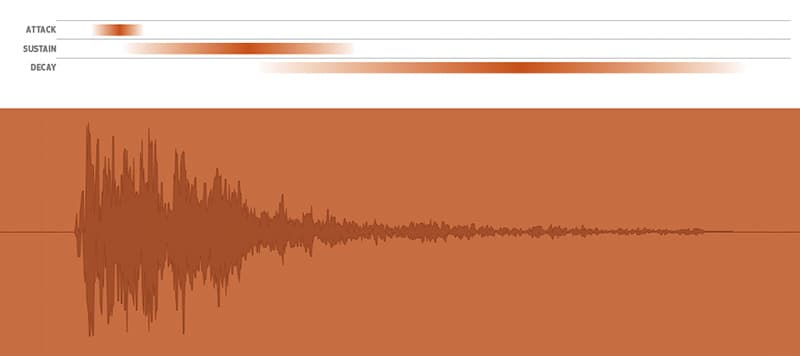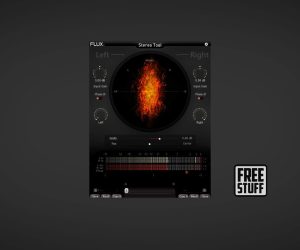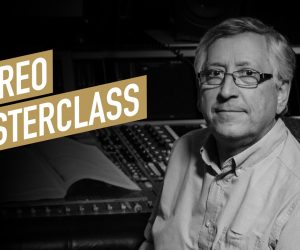
Stereo Mixing: The Art, The Science, The Fiction (Part 3 – Compression)
When it comes to mixing, one of the most commonly misunderstood yet critical devices is the compressor. To some it’s a formidable and baffling tool, but once mastered, the world of mixing opens up like never before. So what makes it such a vital component of any good mix?
Text: Paul McKercher
The earliest example of compression I’ve ever come across appears in the story of the world’s first professional recording engineer/producer, young Fred Gaisberg. Armed with a large hand-cranked gramophone recorder, Fred would stand behind his singers as the mighty contraption chiselled analogue waveforms into beeswax-coated discs, and with a gentle hand on the shoulder, would coax them towards the recording horn for their weaker low register, and drag them back as they hit their glass breaking high notes. In the 110 years since, most everything that was once mechanical in a recording studio, with the exception of microphones and speakers, is now electronic. But given there was no volume control back then, I’m left wondering whether Fred and his performers, upon hearing the playback might have asked: “Can’t we possibly make this louder?”
Sounds familiar doesn’t it. Just as the loudness of those primitive gramophone records was governed by the mechanical limits and design of the record and replay equipment, so too, today’s recordings are constrained by having to remain at, or under digital zero. In short, there’s nothing new about the debate concerning loudness. It’s worth noting that since the introduction of digital audio to the mass market, the peak level of CDs hasn’t changed one iota. It’s the average level, or perceived level, that’s gotten louder in leaps and bounds with the passing decades.
Recently, the debate has been drawn into sharp focus again by the release of recordings that have such high average levels – 11dB above 0VU! – that any semblance of dynamic range (material exhibiting both loud and soft or softer parts) has all but vanished. And if that isn’t bad enough, cheaper domestic replay equipment such as MP3 players and entry-level CD players that were never designed to cope with such high levels, are actually distorting under the strain. Not good.
Most AT readers would be familiar by now with digital limiting software and its ability to make masters really, really loud. Digital limiting, as an extreme form of compression makes all this possible, even for the home recordist. But what’s the point of making mixes so abrasively loud? Indeed, do today’s productions sound any better than they did 10 or 20 years ago? The answer is probably that if it sounds good it is good, and while softer, older recordings may well sound fantastic when listened to in isolation, unfortunately our perception can cause problems when tracks from different sources and decades are played back-to-back. It’s a trick of the ear – or perhaps the mind – that ‘louder’ often translates as ‘better’ and no artist wants their music ignored in an MP3 playlist because the tracks on either side of their masterpiece have more punch and throw. Hence the imperative to make records loud, or at least as loud as other records in the same marketplace. The problem now is that by making records competitively and increasingly louder in the race to attract the listener’s attention, we’ve hit a ceiling. Musicality and dynamic range are being sacrificed to such a degree that a lot of the current releases sound distorted and abrasive, and listening fatigue sets in faster than the time it takes to make a toasted sandwich.
COMPRESSION ON TOAST
What have compressors got to do with all this, you may ask? As tools that diminish dynamic range and thereby increase average level, compressors play an important part in modern mixing techniques, but let’s get this much clear: loudness is neither good nor bad per se. There is good loudness and bad loudness. The former is exciting, attention grabbing and provides suitable contrast to the softer sections of the music (if there are any). More often than not, good loudness is the result of good engineering technique and well-written arrangements. Bad loudness is unnerving, harsh and distorted, leaving your ears feeling tired and worn out. Whether caused by overly hot and clipped signal paths in the recording chain, or soft, limp mixes being over-compressed in mastering, or even CDs mastered so loud that they distort MP3 players, its most usually poor engineering and an emphasis on loudness rather than musicality that’s to blame.
Too often, diligent and skilled mastering engineers complain that they are held hostage to clients’ unrealistic demands about loudness. But the simple fact is; if you take a soft or badly balanced mix and try to master it super-loud, it will indeed sound loud but also, most likely, over-processed, tiring and awful. Now I’m all for loud masters but I don’t like to feel like I’m being bashed over the head with a mouldy pillow after the third song of an album because my ears and my interest are worn out. So when I mix a song, my hope is that the track will have ‘leap’ and ‘punch’ but also enough dynamic range to convey the intent and spirit of the music. Having it as loud as other stylistically similar recordings out there is important, but not as important as the listener having an enjoyable aural experience. Given this, having both dynamic range and loudness may appear to be incompatible but in practice it’s a matter of finding an appropriate balance between the two imperatives.
ATTACK, SUSTAIN & DECAY
I like to think of a good mix as a balance of instruments and frequency bands but also a series of musical entrances and exits, not unlike characters in a stage play where parts, instruments, phrases and even notes and hits have a well defined entry point (attack) and an appropriate exit (decay). Often the entrance of a part, if it can be clearly heard, is enough to grab and hold our attention even after it then makes its way back into the general balance. Compressors are powerful envelope shapers (by envelope I mean the attack, sustain and decay of a sound) and seen in this light we can use them to shape the entrance and exits of the elements in a mix.
For instance, if you were to compress a drum kit using both a fast attack and decay, the effect might be that the attack of the drums is quieter and the sustains and decays louder, giving the impression of the kit being quieter but taking up more space in the mix, the louder decays perhaps masking other elements. The cure, then, to such masking might be to slow the decay time down rather than turning the masked elements up. Similarly, if you were to apply fast attack and decay times to a vocal, the front of the words would be quieter (but more consistent in level), the tails of the notes and breaths between words, louder. It’s effects such as this that make compression such a powerful mixing tool. When mixing I will often spend as much time finessing attack and decay settings as I would doing small, fine balancing fader rides. It’s important too, when listening to results of compression settings, to make judgements based on changes to the entire dynamic shape of the performance, from first note to last, as well as the effect on individual notes or hits.
Unlike listening to EQ, which can be judged almost instantly, the effects of compression require much greater scrutiny and should be made after listening to the entire song. This is particularly true of vocals that can have vastly different envelope shapes and huge dynamic range within a single performance. It may well be that you need several compressor settings within one song and to achieve this I would either automate a plug-in or split the channel to two faders with the different settings on each. As I have stressed in previous articles, you should leave no stone unturned to have the vocal sound fantastic and be the centrepiece and focal point of a mix.
NAILING AN ENVELOPE
In attempting to reduce the dynamic range while retaining the envelope characteristics of any sound, a good starting point is to first think about what kind of envelope shape the signal you’re working on actually has, then have the attack and decay settings of your compressor reflect that shape. For example: a piano with the loudness pedal down has a fast attack and a long decay; a woodblock has both a quick attack and decay, while a bagpipe has a slow attack and an interminable decay. As a ballpark setting on any instrument, first set the attack and release controls to reflect the instrument’s envelope, then set the ratio to determine how much dynamic range reduction you want. Now set the threshold to determine how much of that dynamic range you want to compress – a low threshold if you want all its range compressed, a higher threshold if it’s only the loud bits you want to squash. This is, of course, not a rule, more a guideline. The aim is to maintain the envelope of the compressed sound while reducing its dynamic range so it sounds louder and more consistent, making it sit better in a mix.
Of course, if you wanted to seriously mess with the recorded envelope, go nuts. For instance, to make a drum kit sound as though it’s being clubbed by an angry giant would require lots of analogue compression (and the accompanying distortion that comes with it) with very fast attack and release times. This seems counter-intuitive: how can making the attack quieter give the impression that the drums are being played louder? Well, it’s all in your head apparently. Recently discovered, there’s an anti-loudness protein, nAChR, (I kid you not) located in the sensory hair cells of the inner ear that, when prompted by ‘too loud’ signals from the brain, ‘limits’ the ability of the hairs to respond, thus protecting them from damage. The answer may be that this kind of compression somehow emulates this bio-chemical mechanism, fooling you into thinking the drums are in fact being hit really hard and loudly. Applying such heavy, lacerating compression comes with all sorts of sonic artefacts, such as cymbals with strange decay envelopes and hi-hats that sound like paper tearing, but if that suits the track and it sounds right, then it is right.
Applying such heavy, lacerating compression comes with all sorts of sonic artefacts, such as cymbals with strange decay envelopes and hi-hats that sound like paper tearing, but if that suits the track and it sounds right, then it is right.

SONIC CONSIDERATIONS
As hinted at above, analogue compression usually comes with tonal changes and varying amounts of distortion. One well-known example of this is the Urei 1176LN, one of the greatest compressor designs ever, which to my ear, gently rolls off the super highs and subs, even when it’s not compressing, and adds a subtle but pleasing distortion. Push all four of its ratio buttons in simultaneously and the distortion really cranks up – the so-called ‘British’ mode, an indispensable tool for adding energy and ‘hype’ to a rock vocal.
Any analogue unit worth its salt has a unique sonic signature and that’s why the best mix rooms and the best mixers have rack after rack of them. Not only do they shape the dynamics, they also add subtle textures and flavours to the sound.
In the world of plug-ins, such idiosyncrasies are less common since there’s no physical circuitry involved, which is not to say they aren’t as useful. The precision provided by digital compression and the ability to automate parameters is unmatched in the analogue world and plug-ins such as the Waves C4 multiband compressor and De-esser have no analogue peer. My advice would be to use the tool that best suits the task.
LOUD & BALANCED DRUMS
Let’s take a few examples. Firstly, a drum part played with brushes where the backbeat is a snare rimshot and 8th notes are played by light brushstrokes – the ‘choo-choo train’ beat. Let’s say we already have a reasonably balanced mix (which should be the first order of business when mixing, rather than wasting time and achieving little by EQ’ing every part in solo). You’ve set the balance of the backbeat just about right – a little under the vocal – and its already providing momentum and energy without competing directly with the voice. Nice. Let’s say the problem is that the 8th-note brushstrokes are a bit soft and lacking in detail. Now, we could just simply compress the snare, reducing the range between the loud backbeats and soft brushstrokes but because the overheads and the room mics (which in our example are providing a large part of the snare sound) are, as yet, un-compressed, the balance between them and the snare mic would change each time the snare compressor kicked in. Perhaps a better solution would be to compress the whole drum mix by sending it to a subgroup then inserting a stereo compressor. Maybe, but that might be like using a sledgehammer to squish an ant – too blunt an instrument. A subtler and sonically less destructive method would be to use a stereo compressor in parallel. For the uninitiated, this involves using a compressor as though it were an FX return, so that you’re mixing compressed signal with un-compressed signal in the same way as you would mix wet with dry signal [See Andy Stewart’s Mixing With Parallel Compression article in Issue 44 for more on parallel compression]. This method allows you to be gentler, minimising artefacts and having greater control over how much compressed sound you want in the mix. You’ll retain the attack of the drums by virtue of having a component of uncompressed sound while increasing average level due to the compressed component. Some compressor designs have a mix control on the front panel that essentially does the same thing, only internally. (DAW users should be wary of latency issues when employing parallel compression techniques that may cause the compressed group to phase strangely with the un-compressed, although delay compensation should fix this if your platform has it.)
Returning to the example of a drum kit that sounds as though it’s being pummelled by an angry but talented giant, parallel compression really comes into its own here since you can lower the threshold or increase the ratio (or both) to increase the amount of compression to the point where distortion and artefact are plainly evident while mixing in the un-compressed signal to temper and moderate the wildness of the now heavily squashed drums. With this done, balance the drums with the rest of the mix and finely tweak the attack to give the drums just the right amount of ‘front’ and finesse the decay knob to control how much ambience, cymbal wash and general density you want. It’s worth noting that the faster the decay time the more compressed the signal will sound since the transition from compressed to un-compressed is quicker and hence more noticeable.
HIGH-FREQUENCY COMPRESSION
It’s not unusual for the vocal sounds: ‘k’, ‘c’, ‘sh’, ‘f’, ‘t’, ‘ph’ and ‘th’, to be up to 10dB louder than the vowel sounds in a vocal performance. Sometimes this is because the vocal has been poorly recorded – courtesy of an incorrect mic choice, preamp choice or too much EQ – while at other times it’s simply because the voice is very sibilant. The purpose of a de-esser, then, is to bring these sounds back into balance, which is not to say all vocals need de-essing, though in my experience most vocals do. Note though that the face, neck and chest of a singer are all part of their sound source, but sibilance comes only from the mouth since these sounds are made by the lips, teeth and tongue. My tip to avoid recording too much sibilance is to place the capsule of the vocal mic so that it points at the chin and not the mouth. Generally in a mix, I would have the vocal as bright as, if not a little brighter than the brightest element in a mix, usually the snare drum.
When EQ’ing a vocal, I listen for intelligibility and a pleasing tone, if this means the sibilant parts of the voice are now too loud, it’s time to de-ess. Having found a setting that works, I’d listen closely to every word to be sure the settings are appropriate across the entire performance. If the singer appears to now have a lisp, the de-esser is working too hard; if it seems right for all but a few words, I’d automate the threshold to change at that point. This is where plug-ins really hold their own and are so much more powerful than their analogue counterparts. In extreme cases you may even need two de-essers, one to look after the harder consonant sounds – ‘k’, ‘ch’ and ‘t’ – and a second to tame the ‘s’ sounds; the former being in the 4-5kHz range, the latter around 8-10kHz. While this seems quite convoluted, the vocal should reign supreme and be engaging and a pleasure to listen to from first word to last.
COMPRESSING VOCALS
Vocals need to be heard. That goes without saying, but getting a vocal to sit within the track while also being a clear focal point can take some finesse. It’s important that the listener doesn’t have to strain to understand the lyrics and that the emotional content of the performance is conveyed. Compressing the vocal can help give it the ‘density’ it needs to be clear, without the instruments under it sounding weak or karaoke-machine-like. There are a few things to watch for though. By squashing the dynamic range, the once quiet breaths will now be much louder and can make the singer sound asthmatic. There are two ways around this, the first is to duck the breaths using volume automation and the second is to delete them completely. I’d advocate a mixture of the two since a breath can convey a lot of emotion and have great percussive effect (think Michael Jackson) but if breaths add nothing to the performance, I’d bump them.
Over-compression can also quickly suck the emotion and performance value out of a vocal. If you squeeze the dynamic range so hard that the loudly sung bits are in fact no louder than the soft bits, the impact of the loud section is lost. Generally speaking, the quieter a vocal is in a mix the more it will need to be compressed, so that it still has some impact and occupies enough space to be heard. Once I’ve got a mix just about right, I’ll tweak the attack knob to adjust how loud I want the start of words and phrases to be and then work on the decay time to shape the tails. In terms of attack, sustain and decay, if the vocal features lots of long held notes I’d tend towards slower decay times. Conversely, if it were a rap where the words are short and percussive, a faster decay time is more likely to suit. As always, let your ears be the judge.
MIX BUS COMPRESSION
Using a stereo compressor on the mix bus is a great way to make your mixes louder and sonically bind all the elements together. When choosing a mix bus compressor, however, an important consideration should be its sonic integrity and character. There’s no point working hard on making a mix sound good, only to have a cheap and nasty stereo compressor chew away all that hi-fi goodness.
Mix bus compression can also change the balance, so it’s a good idea to have it across the mix from the word go rather than inserting it in the final stages only to find it changes the mix and undoes a lot of fine balancing. Also, having it on throughout the mix session gives your ears a chance to get used to its effects and allows plenty of time to finesse the settings. The extra energy and density that mix bus compression seems to add, through a reduced dynamic range and the subsequent increased average level, can be very seductive. So be careful not to overdo it. Remember, it can’t be undone once the mix is printed, and besides, you can always compress a little more in mastering.
Some other effects of mix bus compression are that a fast attack will make peaky, percussive elements in a mix quieter but more consistent in their volume, and fast decay times will add ‘fake’ energy and increased density because the decays of many elements in the mix are now that much louder. As a rough guide, I would rarely compress any mix more than 4dB, with an average reduction of 1 – 2dB.
A word about auto-release; this is a setting on many units whereby the decay time adjusts itself automatically depending on the decay time of the audio envelope. For instance, if the music has a lot of short, sticky beats the decay time will be fast, whereas if the music has a smoother more legato feel, the decay time will automatically be slower so as not to make the decays of the music sound unnatural. Auto release has one more trick, and that is that if the level of the audio disappears very quickly while the compressor is in gain reduction, it will ‘hold’ that level of reduction for a period of time after the audio has quickly dropped away. The benefit of this is that if there’s a short pause in the music, the re-entry will not be unduly loud as a result of the compressor opening up, releasing its gain reduction.
If anyone has an audio metaphor that doesn’t involve plumbing or cooking, I’d love to hear it but in conclusion I’d say that compression is to audio what salt is to gastronomy – the right amount brings out and binds all the flavours and its presence can hardly be detected, but add too much and everything is spoilt. Compressors are probably the most powerful sound shaping tools in a studio and require a depth of understanding and a lot of practice to master but with this come mixes with more detail, more impact, greater emotional content and increased, pleasant sounding loudness. The trick, as always, is to listen deeply and keep it musical.
Sources:
- Scientific American, April 2009: Anti Loudness Protein – Kate Wilcox
- The Incredible Music Machine – Lowe/Miller/Boar, Quartet Books.
PREVIOUSLY…
EQ is one of the broadest brush strokes a mix engineer can apply to the sonic canvas; it’s also one of the narrowest. Let’s set up the easel and push some paint around.
READ PART 1
Mixing is becoming more and more complicated as the years progress. With track counts inevitably on the rise what do you do when faced with a complex mix, and how do you learn to do it well?
















RESPONSES